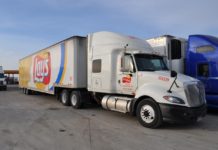
Mercedes-Benz recently released their “Future Truck 2025” vision at the International Commercial Vehicles Show in Germany. It’s high-tech sleek. The white light-emitting diode in the grill turns blue when the truck is in autopilot. Radar sensors scan all sides of the truck to move it down the highway clear of other vehicles.
By 2025, this technology should have its kinks worked out. The first road-legal autonomous truck made a big debut in Nevada. The Freightliner Inspiration Truck is new and shiny but not for everyone. Anxious prognosticators complain that autonomous trucks will destroy jobs and kill the truck stop. Autonomous trucks will replace drivers, millions of them, they say, and make the businesses that cater to them obsolete as well.
The Threat
More than three million truck drivers all over the country stop regularly to eat, drink, rest, and sleep. Entire businesses serve their wants and needs. Restaurants and motels are two examples. So millions more depend for employment on truck drivers.
Restaurant and motel workers along truck routes are also consumers in their local economies. Their spending supports other paychecks in turn. So millions more depend on those who depend on truck drivers for their livelihoods.
Autonomous trucks bring benefits, too. Trucking jobs are dangerous, they take truckers away from their families for long periods of time, they encourage unhealthy habits, and there are over 300,000 heavy truck crashes every year.
But autonomous trucks will take over the roads with unintended effects, insist the pessimists. The potential effect of self-driving vehicle technology on not only truckers themselves but on all the local economies dependent on trucker money are disturbing, decimation of urban economies worse than what happened when construction of the interstate highway system bypassed entire towns.
The American Trucker Association reports 3.5 million truck drivers and 5.2 million additional workers in the trucking business who don’t drive the trucks, in all 8.7 million trucking jobs.
An important detail to consider is that trucking jobs pay well, a middle-class annual income of about $40,000, higher than that of about half of all taxpayers, married households included. Truck driving is one of the rare middle-class jobs that require no post-secondary degree. Truckers are remnants of an increasingly impoverished population once gainfully employed in manufacturing before most of those middle-income jobs went overseas. The incomes of more than 10 million American workers and their families depend partially or entirely on those of truck drivers, who comprise much of what is left of the American middle class.
American Trucker Short-Term Job Outlook
Trucking business leaders anticipate the number of truck-driving jobs to increase by 21 percent by 2020. They also anticipate a worsening shortage of drivers leaving 100,000 jobs with nobody to fill them. Demand higher than supply generally means higher pay, so for the next few years the future for truck drivers looks good. The only thing that could spoil this happy prospect would be if demand suddenly tanked.
The technology for self-driving trucks is already a reality. Google shocked the world when its self-driving car drove 100,000 miles without accident or untoward incident. Such cars have driven over 1.7 million miles with only 11 accidents, all caused by human error, not truck computers, mostly within urban areas.
“And as you might expect,” commented the Google self-driving truck program director, “we see more accidents per mile driven on city streets than on freeways; we were hit eight times in many fewer miles of city driving.”
So in the Google program experience, there is more danger from other drivers within cities than on freeways between them, where fewer technological problems challenged the program developers. Driverless freeway travel is close to the future of self-driving vehicles, so close that it’s already here. On May 6, 2015, the first self-driving truck took to the road in Nevada.
The Freightliner Inspiration Truck may be America’s first street-legal big rig that drives itself. In a press event sponsored by Daimler and the State of Nevada, the corporate chairman and the state governor met to attach the Freightliner’s official autonomous vehicle license plate.
A human will ride in the cab of the truck but as a passenger, not a driver. Instead, the trucker will monitor vehicle systems and traffic conditions and intervene in case of any error. The autonomous truck can read road signs and traffic signals, so it won’t t-bone anyone at a four-way stop. This big rig is big news that shows just how far self-driving tech has come.
Conclusion
Doomsayers who predict that autonomous trucks will “replace drivers, millions of them,” “make the businesses that cater to them obsolete as well,” and decimate “entire small town economies” seem to be unduly alarmist if, as they say, every autonomous truck of the future will have a rider to monitor conditions and to take corrective action in case of anything amiss. The rider presumably would be able to operate the truck if its self-driving system failed, so the reality of a transition to self-driving trucks is that highway safety and truck driver conditions would improve, and the trucking business would realize the undoubted benefits and none of the supposedly dreadful downside of this welcome development in truck transport.
Sources of information and references:
- Gizmodo – Self-Driving Trucks Are Going to Kill Jobs, and Not Just for Drivers
- Carzoos Blog – Trucking Into 2025
- Medium – Self-Driving Trucks Are Going to Hit Us Like a Human-Driven Truck






